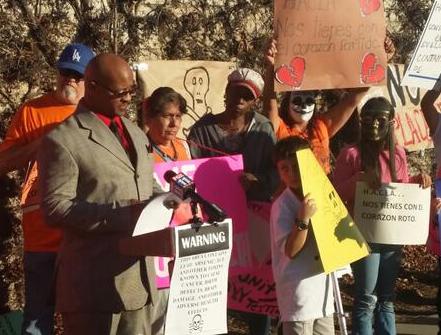Los Angeles Public Housing Residents Face Redevelopment Displacement

Jordan Downs’ public housing residents in Watts, Los Angeles, are fighting the Housing Authority of the City of Los Angeles (HACLA) to save their homes and, quite possibly, their health. With a billion dollar plan that is likely to displace most of the 2,500 residents to make way for a “mixed income” community, HACLA has offered no concrete guarantee to current residents that they can return. Redevelopment in the name of ‘mixed-income’ neighborhoods invariably entails pushing long-term residents and communities out.
Displacement often begins with a surge in arbitrary evictions and encouraged ‘voluntary’ move-outs, helping to clear a path for rapid gentrification. Jordan Downs’ residents have received notices – including for eviction – regarding everything from being 54 cents in arrears to having a long-time pet that had incurred no prior objection. These notices negatively affect the “good standing” status of residents, which residents need to access the new post-development homes, and, even when successfully challenged, create a climate of fear. Adding to this fear is the discovery that the land adjacent to Jordan Downs – acquired as part of the redevelopment – is contaminated with dangerous toxins, putting the health of Jordan Downs’ residents at risk.
HACLA had applied to the federal Department of Housing and Urban Development (HUD) for $30 million in redevelopment funds under the Choice Neighborhoods Initiative – the program that funds the revamping of public housing projects in low-income communities. Throughout the rolling out of this “neighborhood transformation” proposal, the developers and HACLA have painted a picture of an idyllic neighborhood redevelopment – one that current residents will benefit from. But this picture must be viewed in the context of a more than twenty-year history, where at least 261,419 public units have been taken from low-income communities by government policies that profess to safeguard ‘affordable’ housing.
In 1989, when the National Commission on Severely Distressed Public Housing evaluated the state of public housing, six percent of the nation’s 1.4 million units of public housing was declared to be “distressed” and in need of urgent attendance. The misnamed HOPE VI (Housing Opportunity for People Everywhere) program, which flowed from the Commission, was designed to ostensibly revitalize public housing and create sustainable communities via the demolition, rehabilitation, reconfiguration, or replacement of a large number of public housing units. On one level, that sounds like a welcome initiative. But the program was also designed to de-concentrate very low-income communities. In the execution of that de-concentration effort, families are consistently displaced and are left feeling isolated and abandoned. Housing rights activist, and former resident of the St. Bernard Public Housing Projects in New Orleans, Endesha Juakali has critiqued what he sees as the implicit assumption behind ‘mixed-income’ housing initiatives, stating, “It seems they think that by having me live next to a richer person or a White person I will somehow become smarter and better by osmosis.” He believes that the argument advanced claiming ‘mixed-income’ housing as the optimal solution to concentrated poverty supports the belief that poverty is neither structural nor created by policies, but driven by individual behavior and community norms.
The Choice Neighborhoods Initiative – the successor to the HOPE VI Program – has consolidated the idea that the private sector, shaped by market imperatives and not the public good, is the preferred actor in determining whether, and how much, affordable housing is available for low-income individuals and families. Though HACLA’s seeking of funds for redeveloping Jordan Downs was unsuccessful this time around, it is highly likely to apply for this grant again. For Jordan Downs’ residents, past redevelopment projects do not portend well. In a 2010 report on her mission to the United States, the UN Special Rapporteur on the Right to Adequate Housing found that “less than 12 per cent of former public housing residents make it back to live in the redeveloped communities [and] the number of units rebuilt has often not matched the number of units demolished; in fact … the number of new units of public housing has usually been far fewer.” In exemplifying the point through Chicago’s Cabrini Green redevelopment, the Special Rapporteur notes that the high-rise public housing community of 3,114 units had 2,700 of its units demolished, and, at the time of the report, only 305 public housing units had been built in the new developments. Most of the residents who left Cabrini Green during the redevelopment phase are unable to afford to return to the area – they have been permanently displaced.
For the residents of Jordan Downs, this context is cause for grave concern. In addition to facing threats of eviction, receiving intimidating legal notices, and engaging in a fight with HACLA over testing their residential area for harmful toxins, they are fearful that if they have to move – either for adequate remediation of toxins or for the redevelopment to begin – they are highly unlikely to have the option of returning. NESRI is supporting the LA Human Right to Housing Collective and the Los Angeles Community Action Network in their work with residents in seeking to hold HACLA accountable; calling for an end to arbitrary evictions and intimidation against residents; securing an equitable process for redevelopment that meets the needs and protects the rights of the community; and demanding immediate testing and the adequate clean-up of toxins.
The only way to guarantee sustained, truly affordable housing for low-income communities (in Jordan Downs and across the country), is through adequate federal, state, and local investment that does not lead to the scattering of poor communities under the aegis of ‘progress for all’, but rather secures stable housing; generates the conditions for secure, accessible, decently paid work; builds thriving communities with adequate infrastructural support; and, consequently, facilitates flourishing communities irrespective of income-bracket.
